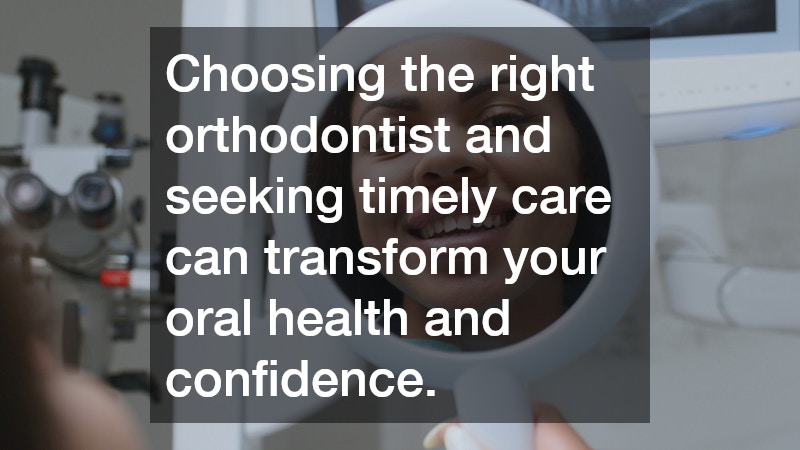
An orthodontist plays a vital role in creating healthy, aligned smiles. Beyond improving appearance, orthodontic care enhances oral function, speech, and confidence. This article explores who orthodontists are, what they do, and when you should consider scheduling an appointment for yourself or your child.
Who is an Orthodontist?
An orthodontist is a dental specialist focused on diagnosing, preventing, and treating misaligned teeth and jaws. They use advanced techniques and appliances such as braces and aligners to correct irregular bites, spacing issues, and jaw imbalances, ensuring optimal dental health and aesthetics.
Educational Background
To become an orthodontist, one must first complete dental school, earning a Doctor of Dental Surgery (DDS) or Doctor of Dental Medicine (DMD) degree. Afterward, they undergo an additional two to three years of specialized orthodontic training to gain certification in this focused field.
Difference Between Dentists and Orthodontists
While both dentists and orthodontists care for oral health, their expertise differs. Dentists handle general dental needs—such as cleanings, fillings, and crowns—while orthodontists focus exclusively on tooth and jaw alignment. If your dental issue involves crooked teeth or bite irregularities, you’ll need an orthodontist’s specialized care.
Common Procedures Performed by Orthodontists
Orthodontists perform various treatments including fitting braces, designing clear aligners, and creating retainers. They also address complex issues like overbites, underbites, and jaw misalignment through surgical and non-surgical methods.
When Should You Visit an Orthodontist?
Knowing when to see an orthodontist can make a major difference in the success and ease of treatment. Early intervention often prevents more complex dental problems later on.
Recommended Age for First Visit
The American Association of Orthodontists recommends that children have their first orthodontic evaluation by age seven. Early visits help detect developing issues such as crowding or improper bite alignment before they worsen.
Signs That You Need Orthodontic Care
Common signs include crooked or overlapping teeth, frequent biting of the cheeks, difficulty chewing, mouth breathing, or jaw pain. Adults may also notice shifting teeth or discomfort when biting—both indicators that orthodontic care is needed.
Routine Check-Ups
Even if no problems are apparent, regular orthodontic check-ups help monitor growth and development. This allows for timely treatment planning if alignment issues begin to appear.
Emergency Situations
Occasionally, orthodontic emergencies occur, such as broken brackets, loose wires, or severe pain after adjustment. In these cases, prompt attention from an orthodontist is crucial to prevent complications or discomfort.
Adult Orthodontics
Orthodontic care isn’t just for children—many adults are choosing to correct long-standing alignment issues with modern, discreet options like clear aligners. Age is no barrier to achieving a healthier, straighter smile.
What Treatments Do Orthodontists Offer?
Orthodontists provide a range of treatment options tailored to different needs, ages, and goals.
Braces
Traditional metal braces remain one of the most effective treatments for complex misalignments. Modern versions are smaller, more comfortable, and less noticeable than those of the past.
Invisalign and Clear Aligners
Invisalign and other clear aligners offer a nearly invisible way to straighten teeth. These removable trays are custom-fitted and allow patients to maintain comfort and convenience during treatment.
Retainers
After active treatment, retainers play a vital role in maintaining alignment. They prevent teeth from shifting back into their previous positions, preserving long-term results.
Surgical Orthodontics
For severe misalignment or jaw discrepancies, surgical orthodontics may be necessary. This advanced procedure combines orthodontic care with oral surgery to correct structural imbalances.
Early Interventional Treatments
For young patients, interceptive orthodontic treatments guide proper jaw growth and tooth eruption, minimizing the need for extensive correction later in life.
How to Choose the Right Orthodontist
Selecting the right orthodontist is essential for achieving optimal results. Consider factors such as qualifications, communication style, and treatment options.
Considerations and Criteria
Look for a provider who offers personalized care plans, modern technology, and a clean, welcoming environment.
Checking Credentials and Experience
Ensure your orthodontist is board-certified and experienced in treating a variety of alignment cases. Experienced specialists often achieve faster and more efficient results.
Consultation Process
During your first consultation, expect a full evaluation, imaging scans, and a discussion of treatment goals. A good orthodontist takes time to answer your questions and explain every option.
Understanding Costs and Insurance Coverage
Orthodontic treatment is an investment in your health. Ask about cost estimates, payment plans, and insurance coverage to make informed financial decisions.
Reviewing Patient Testimonials and Reviews
Reading patient feedback and reviews can provide valuable insight into the orthodontist’s care quality, communication, and results.
Building a Lifetime of Confidence with the Right Orthodontist
Choosing the right orthodontist and seeking timely care can transform your oral health and confidence. Whether for a child’s developing smile or an adult’s renewed self-image, orthodontic treatment provides long-lasting results that extend well beyond appearance. With expert guidance, personalized treatment, and commitment to care, achieving a healthy, radiant smile is within reach at any age.
